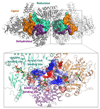The multicatalytic compartment of propionyl-CoA synthase sequesters a toxic metabolite
- PMID: 30374166
- PMCID: PMC6499725
- DOI: 10.1038/s41589-018-0153-x
The multicatalytic compartment of propionyl-CoA synthase sequesters a toxic metabolite
Abstract
Cells must cope with toxic or reactive intermediates formed during metabolism. One coping strategy is to sequester reactions that produce such intermediates within specialized compartments or tunnels connecting different active sites. Here, we show that propionyl-CoA synthase (PCS), an ∼ 400-kDa homodimer, three-domain fusion protein and the key enzyme of the 3-hydroxypropionate bi-cycle for CO2 fixation, sequesters its reactive intermediate acrylyl-CoA. Structural analysis showed that PCS forms a multicatalytic reaction chamber. Kinetic analysis suggested that access to the reaction chamber and catalysis are synchronized by interdomain communication. The reaction chamber of PCS features three active sites and has a volume of only 33 nm3. As one of the smallest multireaction chambers described in biology, PCS may inspire the engineering of a new class of dynamically regulated nanoreactors.
Conflict of interest statement
Figures




Similar articles
-
Propionyl-coenzyme A synthase from Chloroflexus aurantiacus, a key enzyme of the 3-hydroxypropionate cycle for autotrophic CO2 fixation.J Biol Chem. 2002 Apr 5;277(14):12137-43. doi: 10.1074/jbc.M110802200. Epub 2002 Jan 30. J Biol Chem. 2002. PMID: 11821399
-
3-Hydroxypropionyl-coenzyme A synthetase from Metallosphaera sedula, an enzyme involved in autotrophic CO2 fixation.J Bacteriol. 2008 Feb;190(4):1383-9. doi: 10.1128/JB.01593-07. Epub 2007 Dec 28. J Bacteriol. 2008. PMID: 18165310 Free PMC article.
-
Characterization of the propionyl-CoA synthetase (PrpE) enzyme of Salmonella enterica: residue Lys592 is required for propionyl-AMP synthesis.Biochemistry. 2002 Feb 19;41(7):2379-87. doi: 10.1021/bi015647q. Biochemistry. 2002. PMID: 11841231
-
Conformational dynamics in the Acyl-CoA synthetases, adenylation domains of non-ribosomal peptide synthetases, and firefly luciferase.ACS Chem Biol. 2009 Oct 16;4(10):811-27. doi: 10.1021/cb900156h. ACS Chem Biol. 2009. PMID: 19610673 Free PMC article. Review.
-
Acyl-CoA metabolism and partitioning.Annu Rev Nutr. 2014;34:1-30. doi: 10.1146/annurev-nutr-071813-105541. Epub 2014 Apr 10. Annu Rev Nutr. 2014. PMID: 24819326 Free PMC article. Review.
Cited by
-
From Protein Film Electrochemistry to Nanoconfined Enzyme Cascades and the Electrochemical Leaf.Chem Rev. 2023 May 10;123(9):5421-5458. doi: 10.1021/acs.chemrev.2c00397. Epub 2022 Dec 27. Chem Rev. 2023. PMID: 36573907 Free PMC article. Review.
-
Metabolic channeling: predictions, deductions, and evidence.Mol Cell. 2021 Sep 16;81(18):3775-3785. doi: 10.1016/j.molcel.2021.08.030. Mol Cell. 2021. PMID: 34547238 Free PMC article. Review.
-
Protein crystal structure determination with the crystallophore, a nucleating and phasing agent.J Appl Crystallogr. 2019 Jun 28;52(Pt 4):722-731. doi: 10.1107/S1600576719006381. eCollection 2019 Aug 1. J Appl Crystallogr. 2019. PMID: 31396026 Free PMC article.
-
Lethal metabolism of Candida albicans respiratory mutants.PLoS One. 2024 Apr 5;19(4):e0300630. doi: 10.1371/journal.pone.0300630. eCollection 2024. PLoS One. 2024. PMID: 38578754 Free PMC article.
-
New-to-nature CO2-dependent acetyl-CoA assimilation enabled by an engineered B12-dependent acyl-CoA mutase.Nat Commun. 2024 Nov 26;15(1):10235. doi: 10.1038/s41467-024-53762-9. Nat Commun. 2024. PMID: 39592584 Free PMC article.
References
-
- Wheeldon I, et al. Substrate channelling as an approach to cascade reactions. Nat Chem. 2016;8:299–309. - PubMed
-
- Linster CL, Van Schaftingen E, Hanson AD. Metabolite damage and its repair or pre-emption. Nat Chem Biol. 2013;9:72–80. - PubMed
-
- Wheeldon I, et al. Substrate channelling as an approach to cascade reactions. Nature chemistry. 2016;8:299. - PubMed
-
- Alber BE, Fuchs G. Propionyl-coenzyme A synthase from Chloroflexus aurantiacus, a key enzyme of the 3-hydroxypropionate cycle for autotrophic CO2 fixation. J Biol Chem. 2002;277:12137–12143. - PubMed
Publication types
MeSH terms
Substances
Grants and funding
LinkOut - more resources
Full Text Sources
Research Materials

